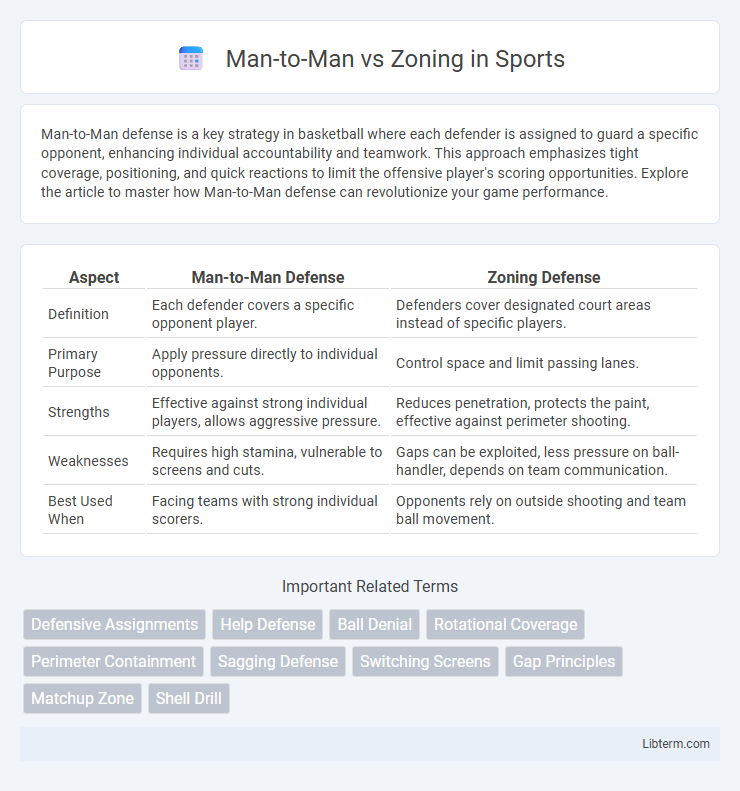Man-to-Man defense is a key strategy in basketball where each defender is assigned to guard a specific opponent, enhancing individual accountability and teamwork. This approach emphasizes tight coverage, positioning, and quick reactions to limit the offensive player's scoring opportunities. Explore the article to master how Man-to-Man defense can revolutionize your game performance.
Table of Comparison
| Aspect | Man-to-Man Defense | Zoning Defense |
|---|---|---|
| Definition | Each defender covers a specific opponent player. | Defenders cover designated court areas instead of specific players. |
| Primary Purpose | Apply pressure directly to individual opponents. | Control space and limit passing lanes. |
| Strengths | Effective against strong individual players, allows aggressive pressure. | Reduces penetration, protects the paint, effective against perimeter shooting. |
| Weaknesses | Requires high stamina, vulnerable to screens and cuts. | Gaps can be exploited, less pressure on ball-handler, depends on team communication. |
| Best Used When | Facing teams with strong individual scorers. | Opponents rely on outside shooting and team ball movement. |
Introduction to Defensive Basketball Strategies
Man-to-man defense in basketball involves each defender closely guarding a specific opponent, emphasizing individual accountability and pressure, which disrupts offensive flow and limits scoring opportunities. In contrast, zoning defense assigns players to cover designated areas on the court, effectively protecting the paint and forcing opponents into low-percentage outside shots. Understanding the strengths and weaknesses of these defensive strategies is crucial for coaches and players to adapt their game plans against varying offensive tactics.
Defining Man-to-Man Defense
Man-to-man defense is a basketball strategy where each defender is responsible for guarding a specific offensive player, aiming to limit their scoring opportunities and force turnovers. This defensive approach relies on individual player skills such as footwork, speed, and anticipation to maintain close coverage and apply pressure. Man-to-man defense contrasts with zoning by prioritizing direct opponent engagement over guarding designated court areas.
Understanding Zone Defense
Zone defense emphasizes spatial control, assigning each player to guard a specific area rather than a single opponent, which can disrupt passing lanes and force outside shots. It requires effective communication and quick rotations to cover gaps and double-team ball handlers strategically. Mastering zone defense demands players to read offensive patterns and adjust positioning to neutralize scoring threats within their designated zones.
Key Differences Between Man-to-Man and Zone
Man-to-man defense requires each player to guard a specific opponent, emphasizing individual matchups and quick reaction to offensive moves. Zone defense assigns players to cover designated areas on the court, prioritizing team coordination and collective spatial awareness. The primary difference lies in man-to-man's focus on direct opponent pressure versus zone's strategy of protecting key zones and limiting penetration.
Advantages of Man-to-Man Defense
Man-to-man defense offers precise defensive coverage by assigning each player to mark a specific opponent, enhancing accountability and reducing scoring opportunities. This strategy allows for tailored pressure on key offensive threats, disrupting their rhythm and forcing difficult shots. Improved communication and switching on screens also create dynamic defensive adjustments, making man-to-man effective in both perimeter and post defense.
Benefits of Zone Defense
Zone defense enhances team coverage by assigning players to specific areas, reducing the risk of defensive mismatches against skilled individual scorers. This strategy improves help defense and rebounding opportunities by positioning defenders closer to the basket and key zones. Teams using zone defense can conserve player energy while disrupting opponents' offensive rhythms and limiting passing lanes.
Situational Uses: When to Deploy Each Defense
Man-to-man defense excels in situations requiring tight, individualized coverage against skilled scorers or in late-game scenarios demanding intense pressure. Zoning defense is more effective for protecting the paint, disrupting passing lanes, and conserving player energy during prolonged defensive stands or when facing teams with strong perimeter shooters. Coaches deploy man-to-man defense against opponents with dominant one-on-one players, while zoning is preferred to counteract offensive spacing or exploit mismatches in player speed or agility.
Common Challenges and Counter-Tactics
Man-to-Man defense often struggles with mismatches and requires high individual athleticism, leading to vulnerabilities against skilled isolators and quick ball movement. Zoning defenses face challenges in contesting outside shooting and securing defensive rebounds due to less aggressive perimeter pressure. Effective counter-tactics include off-ball screens and rapid ball reversals to exploit man-to-man gaps, while offenses attack zone defense by overloading zones and utilizing high-post flashes to disrupt spatial coverage.
Impact on Player Development and Team Dynamics
Man-to-man defense fosters individual skill growth by emphasizing one-on-one matchups that enhance defensive techniques, anticipation, and physical conditioning. Zoning defense promotes team cohesion and communication by requiring players to cover specific areas, improving spatial awareness and collective decision-making. Balancing both strategies can cultivate versatile athletes who excel in personal accountability and collaborative gameplay, enhancing overall team performance.
Conclusion: Choosing the Right Defense Strategy
Selecting the right defense strategy depends on team dynamics, player skills, and opponent tendencies; man-to-man defense offers personalized pressure and adaptability, while zoning provides collective coverage and helps protect key interior areas. Teams with versatile, athletic defenders benefit from man-to-man schemes, whereas squads with height and length advantage excel in zoning to control space and force perimeter shots. Coaches must evaluate their roster strengths and game scenarios to implement a defense that maximizes effectiveness and counters opposing offensive strategies.
Man-to-Man Infographic

 libterm.com
libterm.com